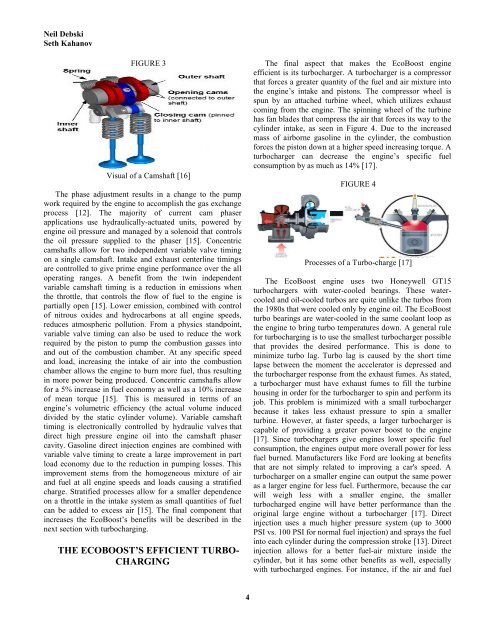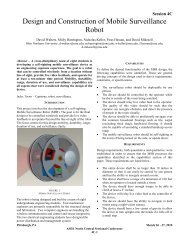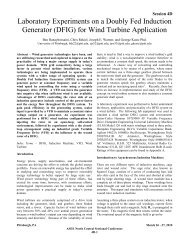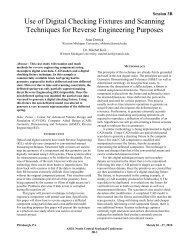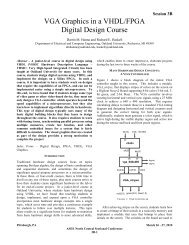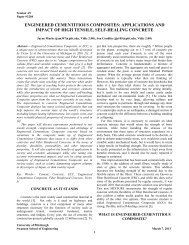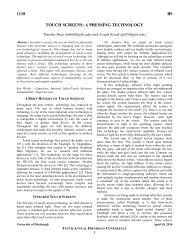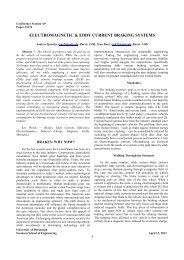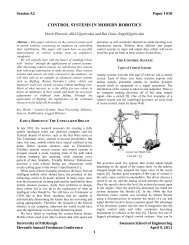THE ECOBOOST ENGINE: COMBINING VARIABLE VALVE TIMING ...
THE ECOBOOST ENGINE: COMBINING VARIABLE VALVE TIMING ...
THE ECOBOOST ENGINE: COMBINING VARIABLE VALVE TIMING ...
You also want an ePaper? Increase the reach of your titles
YUMPU automatically turns print PDFs into web optimized ePapers that Google loves.
Neil Debski<br />
Seth Kahanov<br />
FIGURE 3<br />
Visual of a Camshaft [16]<br />
The phase adjustment results in a change to the pump<br />
work required by the engine to accomplish the gas exchange<br />
process [12]. The majority of current cam phaser<br />
applications use hydraulically-actuated units, powered by<br />
engine oil pressure and managed by a solenoid that controls<br />
the oil pressure supplied to the phaser [15]. Concentric<br />
camshafts allow for two independent variable valve timing<br />
on a single camshaft. Intake and exhaust centerline timings<br />
are controlled to give prime engine performance over the all<br />
operating ranges. A benefit from the twin independent<br />
variable camshaft timing is a reduction in emissions when<br />
the throttle, that controls the flow of fuel to the engine is<br />
partially open [15]. Lower emission, combined with control<br />
of nitrous oxides and hydrocarbons at all engine speeds,<br />
reduces atmospheric pollution. From a physics standpoint,<br />
variable valve timing can also be used to reduce the work<br />
required by the piston to pump the combustion gasses into<br />
and out of the combustion chamber. At any specific speed<br />
and load, increasing the intake of air into the combustion<br />
chamber allows the engine to burn more fuel, thus resulting<br />
in more power being produced. Concentric camshafts allow<br />
for a 5% increase in fuel economy as well as a 10% increase<br />
of mean torque [15]. This is measured in terms of an<br />
engine’s volumetric efficiency (the actual volume induced<br />
divided by the static cylinder volume). Variable camshaft<br />
timing is electronically controlled by hydraulic valves that<br />
direct high pressure engine oil into the camshaft phaser<br />
cavity. Gasoline direct injection engines are combined with<br />
variable valve timing to create a large improvement in part<br />
load economy due to the reduction in pumping losses. This<br />
improvement stems from the homogeneous mixture of air<br />
and fuel at all engine speeds and loads causing a stratified<br />
charge. Stratified processes allow for a smaller dependence<br />
on a throttle in the intake system as small quantities of fuel<br />
can be added to excess air [15]. The final component that<br />
increases the EcoBoost’s benefits will be described in the<br />
next section with turbocharging.<br />
<strong>THE</strong> <strong>ECOBOOST</strong>’S EFFICIENT TURBO-<br />
CHARGING<br />
The final aspect that makes the EcoBoost engine<br />
efficient is its turbocharger. A turbocharger is a compressor<br />
that forces a greater quantity of the fuel and air mixture into<br />
the engine’s intake and pistons. The compressor wheel is<br />
spun by an attached turbine wheel, which utilizes exhaust<br />
coming from the engine. The spinning wheel of the turbine<br />
has fan blades that compress the air that forces its way to the<br />
cylinder intake, as seen in Figure 4. Due to the increased<br />
mass of airborne gasoline in the cylinder, the combustion<br />
forces the piston down at a higher speed increasing torque. A<br />
turbocharger can decrease the engine’s specific fuel<br />
consumption by as much as 14% [17].<br />
FIGURE 4<br />
Processes of a Turbo-charge [17]<br />
The EcoBoost engine uses two Honeywell GT15<br />
turbochargers with water-cooled bearings. These watercooled<br />
and oil-cooled turbos are quite unlike the turbos from<br />
the 1980s that were cooled only by engine oil. The EcoBoost<br />
turbo bearings are water-cooled in the same coolant loop as<br />
the engine to bring turbo temperatures down. A general rule<br />
for turbocharging is to use the smallest turbocharger possible<br />
that provides the desired performance. This is done to<br />
minimize turbo lag. Turbo lag is caused by the short time<br />
lapse between the moment the accelerator is depressed and<br />
the turbocharger response from the exhaust fumes. As stated,<br />
a turbocharger must have exhaust fumes to fill the turbine<br />
housing in order for the turbocharger to spin and perform its<br />
job. This problem is minimized with a small turbocharger<br />
because it takes less exhaust pressure to spin a smaller<br />
turbine. However, at faster speeds, a larger turbocharger is<br />
capable of providing a greater power boost to the engine<br />
[17]. Since turbochargers give engines lower specific fuel<br />
consumption, the engines output more overall power for less<br />
fuel burned. Manufacturers like Ford are looking at benefits<br />
that are not simply related to improving a car's speed. A<br />
turbocharger on a smaller engine can output the same power<br />
as a larger engine for less fuel. Furthermore, because the car<br />
will weigh less with a smaller engine, the smaller<br />
turbocharged engine will have better performance than the<br />
original large engine without a turbocharger [17]. Direct<br />
injection uses a much higher pressure system (up to 3000<br />
PSI vs. 100 PSI for normal fuel injection) and sprays the fuel<br />
into each cylinder during the compression stroke [13]. Direct<br />
injection allows for a better fuel-air mixture inside the<br />
cylinder, but it has some other benefits as well, especially<br />
with turbocharged engines. For instance, if the air and fuel<br />
4


